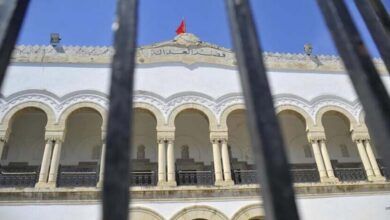The Tunisian Brotherhood and the Gabès Protests: Chaos to Undermine Public Anger

Although they showed no concern during their years in power for Gabès’ suffering caused by pollution from the chemical plant, the Brotherhood’s leaders are now reemerging with a different goal.
What Tunisia’s Brotherhood is doing today—inciting discord, sowing division, and turning people against their president—is not very different from what has occurred during previous waves of popular anger, whose participants had peaceful and legitimate demands.
-
The Tunisian Brotherhood… Exploiting crises to inflame the streets and attempt a political comeback
-
On the Eve of the Verdict… Documents Reveal Tunisian Brotherhood’s Plot to Assassinate Kais Saied
In Gabès, a governorate currently witnessing protests demanding immediate solutions to pollution from a local chemical factory, observers were unsurprised by the group’s behavior.
The Brotherhood quickly exploited the protests of residents in this southeastern region by using their social media platforms to encourage confrontation with security forces under false revolutionary slogans.
Rafik Abdessalem, a Brotherhood leader, former foreign minister, and son-in-law of the movement’s chief Rached Ghannouchi, wrote on his pages that “the next revolution will start from Gabès.”
-
The Tunisian Brotherhood and the Blood of Brahmi… “The Wolf’s Cloak” Does Not Absolve the Sin
-
Tunisian Brotherhood: Arrest of 80 Leaders from the Ennahdha Movement. What Are the Charges?
No political grandstanding
In an implicit response, Tunisian President Kaïs Saïed recently emphasized that “there will be no tolerance for those who neglect their duties, and these circumstances cannot be used for political gain, whether from within or from abroad.”
He added, as quoted by the presidency: “Our people in Gabès, like everywhere else, will receive their full rights. They are the ones who will build the new Tunisia they aspire to—a green Tunisia, free from all forms of pollution and from those who pollute.”
The protests in Gabès, sparked by repeated cases of suffocation caused by factory emissions, have continued since last week.
-
Tunisian Brotherhood: Conspiracies to “Reposition” Before Presidential Elections
-
“The Tunisian Brotherhood Move”… The Buzz of Rumors Precedes Elections
According to local reports, more than one hundred people have been hospitalized in the past two months, September and October.
The Gabès chemical complex, located in Ghannouch about 415 kilometers from Tunis, provides approximately 4,000 jobs.
Last Saturday, during a meeting with the Minister of Industry and Mines, Fatma Thabet, and the Minister of Environment, Habib Obeid, President Saïed instructed a joint ministerial team to visit the phosphoric acid plant “to fix what needs to be fixed as quickly as possible,” according to an official statement.
-
The Tunisian Brotherhood Anticipates Conspiracies Against the Country and Launches a New Maneuver… What Is It?
-
The Spoiled Son of Rached Ghannouchi… Who is the Tunisian Brotherhood member Seifeddine Makhlouf ?
A pressure card
Political observers note that, amid the Brotherhood’s ongoing political decline, the group continues to “ride the wave” of spontaneous protests, using them as leverage against President Saïed.
Tunisian political analyst Abdelmajid Al-Adwani stated that “the residents’ demands are legitimate, particularly given the severe environmental degradation caused by poor decisions over many years.”
He added, “Turning these legitimate grievances into violence and chaos, with Molotov cocktails and the burning of the chemical complex’s administrative building, is both unacceptable and intentional.”
-
New Maneuver to Revive His Name… Leader of the Tunisian Brotherhood Enters Hunger Strike from Inside His Prison
-
Time is running out for the Tunisian Brotherhood… Only a few months remain to close the chapter on the human trafficking networks
He warned that “the Brotherhood continues to disrupt public order and inflame tensions, hoping to return to the political scene through another route.”
According to him, Gabès—especially its southern part—has been a stronghold for Ennahdha since 2011, as many of its top leaders, including Rached Ghannouchi and Rafik Abdessalem, come from the area.
Since the start of the protests, Rafik Abdessalem has used his social media pages, reportedly managed from abroad, to incite Tunisians to confront security forces.
-
The Tunisian Brotherhood continues to spread rumors to manipulate international public opinion
-
Corruption of the Tunisian Brotherhood… Calls for an investigation into the “Employee Army” file
Past indifference
Meanwhile, Tunisian activist and political analyst Nabil Ghouari said that Gabès residents have suffered for decades from pollution problems linked to the chemical plant.
He explained that “the Ennahdha movement, a major player in power since 2011, is largely responsible for the worsening environmental situation in Gabès and never sought to address residents’ grievances at the time.”
He added that “local inhabitants had already demanded the closure of the plant in 2011, but Ennahdha ignored them, focused only on its narrow partisan interests.”
-
A blow to the Tunisian Brotherhood – New leaders in the grip of the judiciary
-
Spreading terror and rumors – What comes after the failure of the Tunisian Brotherhood to rally?
Established in 1972, the chemical plant is part of the state-owned Tunisian Chemical Group, specializing in converting phosphate into phosphoric acid.
Between 1979 and 1985, two diammonium phosphate fertilizer units were built, and in 1983, an ammonium nitrate plant was added.
This vast industrial complex processes phosphate from the neighboring Gafsa mines to produce fertilizers and other chemical materials.












